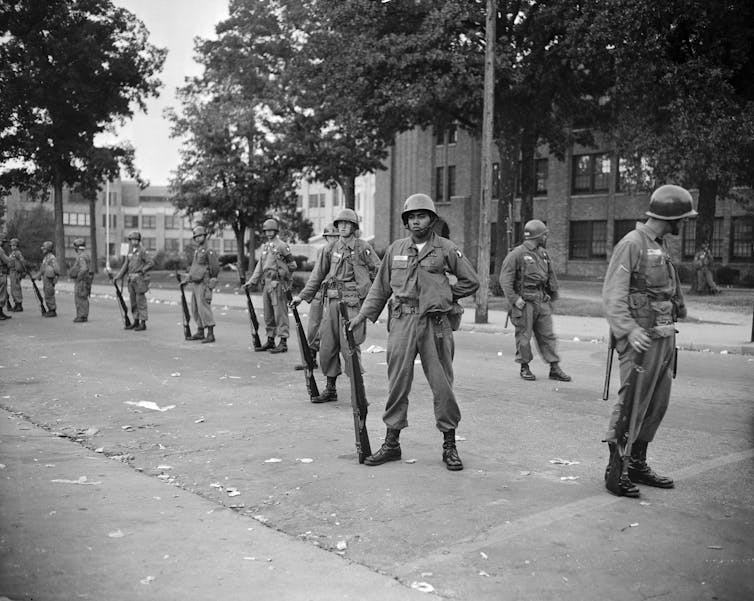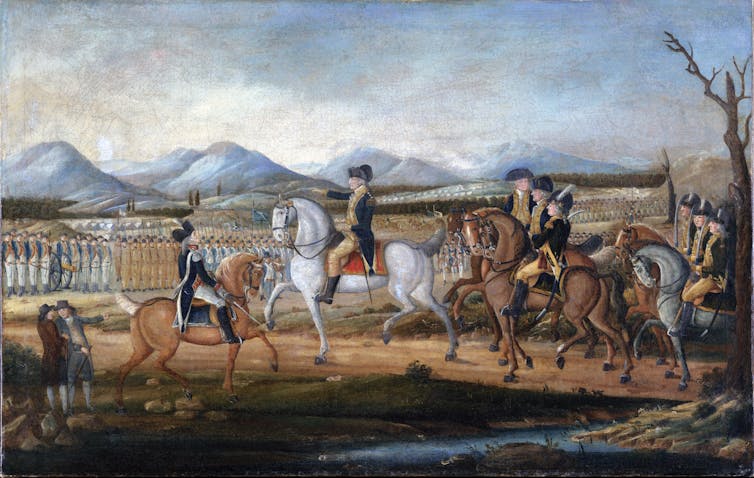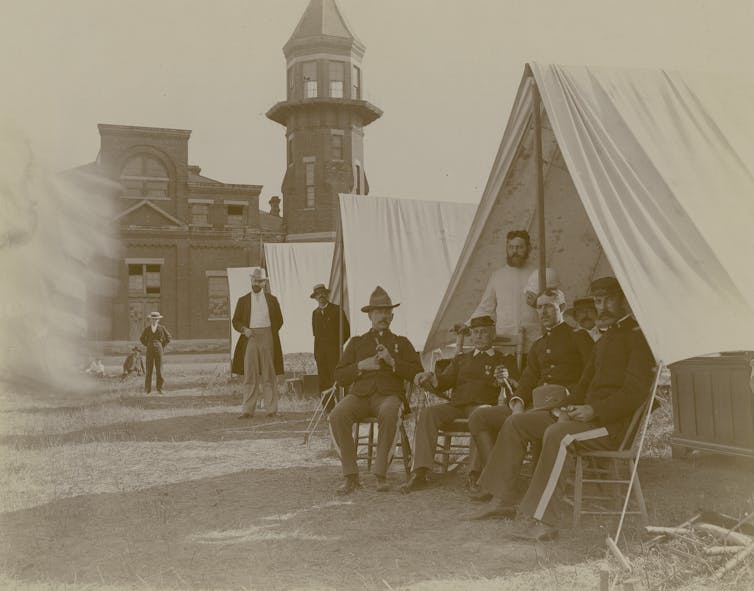Don't want federal agents in your city or town? Then protect federal property
- Written by Frank V. Zerunyan, Professor of the Practice of Governance, University of Southern California
I recently visited Portland, Oregon, and saw the destruction around the federal courthouse there – walls defaced with graffiti[1], fences vandalized, and the remains of garbage fires that had been set.
The vast majority of anti-racism protests over the past two months in the city have reportedly been peaceful[2], and the damage was due to a small minority of rioters who fought police and federal agents around the building.
President Donald Trump sent in federal agents[3], claiming Portland was no longer able to maintain order and adequately protect federal property.
The agents’ uninvited presence, and how they purportedly treated protesters, escalated the conflict. The city’s mayor and Oregon’s governor repeatedly asked the agents to leave; the state attorney general sued to restrict the operations of federal agents[4]. The federal presence, they said, violated the 10th Amendment, which guarantees a state’s sovereign right to police its citizens. A federal judge in Portland rejected the state’s arguments for lack of standing.
As a three-term mayor and city council member, as well as a legal scholar[5], I know that what’s called “home rule,” or local control, is the most sacred refrain in the vocabulary of every mayor and council member I know.
At the same time, the scene I witnessed at the federal courthouse in Portland is disturbing. As political interests on both sides fuel the fire of the violence[6], the American people are left wondering if federal agents will appear in their cities next.
 Federal troops were sent by President Dwight Eisenhower to Little Rock, Ark., in 1957 to protect Black students from mob violence when they integrated a city high school.
Bettmann/Getty[7]
Federal troops were sent by President Dwight Eisenhower to Little Rock, Ark., in 1957 to protect Black students from mob violence when they integrated a city high school.
Bettmann/Getty[7]
State sovereignty, freedom, independence
The Founders feared an authoritarian central government[8]. They worked to create[9] a functional republic strong enough to enforce national interests but limited enough to assure individual self-determination where citizens lived and worked.
While the concept of the municipality, and therefore home rule or local control, is not described in the United States Constitution, the 10th Amendment guarantees such local authority to the people through the states[10].
The concept of decentralized governance predates the 10th Amendment. Article II of the 1777 Articles of Confederation[11], the predecessor to the Constitution, grants each state “sovereignty, freedom and independence[12].” The 10th Amendment is the natural progression of Article II.
The constitution of each state is where “local control” is spelled out in detail, including police powers to help govern public health, safety and welfare. Since 1824, the U.S. Supreme Court has affirmed the right of states to exercise these police powers[13], including, in the current context, quarantine laws and health laws of every description.
Over the years, more conservative Supreme Court justices have specifically invoked the principle of reserving police powers to states. Justice William Rehnquist, in striking down a federal law which prohibited bringing a gun into a school zone, said that law threatened to convert federal authority into a “general police power of the sort retained by the states[14].”
 George Washington and his troops in Maryland, before their march to suppress the Whiskey Rebellion in western Pennsylvania.
Wikimedia, from the collection of the Metropolitan Museum of Art[15]
George Washington and his troops in Maryland, before their march to suppress the Whiskey Rebellion in western Pennsylvania.
Wikimedia, from the collection of the Metropolitan Museum of Art[15]
From Whiskey Rebellion to LBJ
How can the federal police intervention today in American cities be reconciled with the well-established jurisprudence on state sovereignty and the recognition of local police powers?
The question has been especially acute in Portland, where local authorities claimed[16] that there was no need or urgency to use federal police power to quell local protests.
But this claim is a matter of opinion and perhaps a misinterpretation of well-settled law.
The conflict between central national power and local police power finds its roots in the Whiskey Rebellion of 1794[17].
Farmers in western Pennsylvania objected to an excise tax imposed on them as an abuse of federal authority. The protests became violent. When the home of the regional tax collector was burned, President George Washington had little choice but to stop the violence[18], which threatened the Union’s stability.
In 1807, President Thomas Jefferson signed into law the Insurrection Act[19]. This act empowers the American president as commander in chief to deploy military troops within the U.S. in particular circumstances. It’s the same act that President Trump threatened to use in American cities.
In 1827, Supreme Court Justice Joseph Story – based on the act and speaking for the majority of the court – vested in the president the authority to use federal power to enforce federal law.
Justice Story wrote[20], “We are all of opinion that the authority to decide whether the exigency has arisen belongs exclusively to the President, and that his decision is conclusive upon all other persons.”
Subsequent acts of Congress between 1860 and 2001 gave the president broader powers[21] to decide the conditions justifying the use of state militia by the federal government[22].
Presidents subsequently used that power to enforce federal law inside states.
In his first inaugural address[23], in 1861, President Abraham Lincoln declared his constitutional mandate to execute federal law faithfully against threats of Southern states withdrawing from the Union. He then sent federal troops to Confederate South Carolina based on the argument that he must enforce federal law and protect Fort Sumter, which was federal property[24].
In 1894, Eugene Debs led a national railroad strike of 125,000 workers[25] that ultimately disrupted the U.S. mail system. A federal circuit court forbid the strike. Debs and his colleagues ignored the order. Rioting ensued and President Grover Cleveland sent federal troops into Illinois[26] over the objections of Governor John Peter Altgeld.
 President Grover Cleveland sent troops to Illinois in 1894 to quell the Pullman Strike, over the governor’s objections.
Chicago History Museum/Getty Images[27]
President Grover Cleveland sent troops to Illinois in 1894 to quell the Pullman Strike, over the governor’s objections.
Chicago History Museum/Getty Images[27]
By 1895, the Debs case had been appealed to the Supreme Court, challenging the authority of the president to use federal power to enforce federal law in a state. The court concluded that, in the case of a threat to federal law deemed critical by the president, the “army of the nation, and all its militia, are at the service of the nation to compel obedience to its laws[28].”
In 1954, to enforce the desegregation ruling in Brown v. Board of Education, President Dwight Eisenhower federalized the Arkansas National Guard[29] and sent them, along with Army units, to protect nine Black students as they integrated a Little Rock school amid violent opposition by segregationists.
Similarly, President John F. Kennedy sent federal troops to Mississippi and Alabama[30] to help integrate the Universities of Mississippi and Alabama.
In 1967, during the deadly riots between police and residents in Detroit, President Lyndon B. Johnson intervened and sent federal troops to control the unrest. He sent federal troops to Chicago in 1968 in response to protests sparked by the assassination of Martin Luther King Jr.[31][32]
Strong exception
Previous presidents had a constitutional duty and authority to faithfully execute the laws of the United States, including sending federal officers to protect federal property and enforce federal law. What is the argument against President Trump doing the same?
The lesson here is for state and local officials to implement the law and protect federal property[33]. Gov. Kate Brown of Oregon reportedly agreed to secure the Federal Courthouse[34] in return for the departure of the federal agents.
President Kennedy, while sending federal troops to Birmingham, Alabama in 1963, said he hoped the citizens of Birmingham themselves[35] would maintain “standards of responsible conduct that will make outside intervention unnecessary.”
[Insight, in your inbox each day. You can get it with The Conversation’s email newsletter[36].]
What is compelling, however, in this conflict between federal and local authority are the words of Justice Story in 1827: “A free people are naturally jealous of the exercise of military power, and the power to call the militia into actual service is certainly felt to be one of no ordinary magnitude. But it is not a power which can be executed without a correspondent responsibility.”
The conduct of federal officials in protecting the civil rights of citizens in Portland under the First, Fourth and Fifth Amendments of the Constitution will remain under scrutiny.
But a president’s right to execute federal law and protect federal property will remain a strong exception to local control and local police power guaranteed by the 10th Amendment.
References
- ^ walls defaced with graffiti (www.youtube.com)
- ^ have reportedly been peaceful (www.usatoday.com)
- ^ President Donald Trump sent in federal agents (www.usatoday.com)
- ^ the state attorney general sued to restrict the operations of federal agents (theconversation.com)
- ^ a legal scholar (priceschool.usc.edu)
- ^ As political interests on both sides fuel the fire of the violence (www.nytimes.com)
- ^ Bettmann/Getty (www.gettyimages.com)
- ^ Founders feared an authoritarian central government (www.inquirer.com)
- ^ They worked to create (ir.lawnet.fordham.edu)
- ^ 10th Amendment guarantees such local authority to the people through the states (ir.lawnet.fordham.edu)
- ^ Articles of Confederation (www.ourdocuments.gov)
- ^ sovereignty, freedom and independence (www.govinfo.gov)
- ^ U.S. Supreme Court has affirmed the right of states to exercise these police powers (supreme.justia.com)
- ^ general police power of the sort retained by the states (www.law.cornell.edu)
- ^ Wikimedia, from the collection of the Metropolitan Museum of Art (commons.wikimedia.org)
- ^ where local authorities claimed (www.npr.org)
- ^ Whiskey Rebellion of 1794 (www.mountvernon.org)
- ^ little choice but to stop the violence (www.pbs.org)
- ^ Insurrection Act (theconversation.com)
- ^ Justice Story wrote (supreme.justia.com)
- ^ gave the president broader powers (engagedscholarship.csuohio.edu)
- ^ justifying the use of state militia by the federal government (www.law.cornell.edu)
- ^ first inaugural address (avalon.law.yale.edu)
- ^ protect Fort Sumter, which was federal property (www.smithsonianmag.com)
- ^ Eugene Debs led a national railroad strike of 125,000 workers (www.britannica.com)
- ^ President Grover Cleveland sent federal troops into Illinois (www.britannica.com)
- ^ Chicago History Museum/Getty Images (www.gettyimages.com)
- ^ army of the nation, and all its militia, are at the service of the nation to compel obedience to its laws (constitutionallawreporter.com)
- ^ federalized the Arkansas National Guard (www.history.com)
- ^ sent federal troops to Mississippi and Alabama (www.jfklibrary.org)
- ^ deadly riots between police and residents (www.smithsonianmag.com)
- ^ response to protests sparked by the assassination of Martin Luther King Jr. (millercenter.org)
- ^ state and local officials to implement the law and protect federal property (www.nytimes.com)
- ^ agreed to secure the Federal Courthouse (www.washingtonpost.com)
- ^ said he hoped the citizens of Birmingham themselves (www.upi.com)
- ^ You can get it with The Conversation’s email newsletter (theconversation.com)
Authors: Frank V. Zerunyan, Professor of the Practice of Governance, University of Southern California

